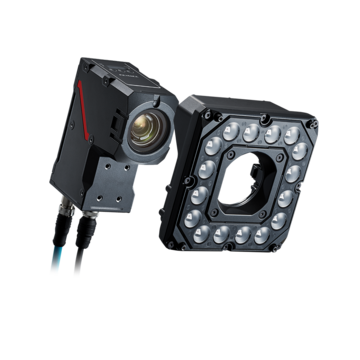Vision Systems
- Vision System with Built-in AI VS series
- Intuitive Vision System CV-X series
- Customizable Vision System XG-X series
- GigE camera and lighting for PC-based machine vision VJ series
- Inline 3D Inspection 3D Vision series
- 3D Vision-Guided Robotics 3D VGR series
- Line Scan Technology Line Scan series
- 2D Vision-Guided Robotics 2D VGR series
- LED Lighting CA-D series
- Lenses (for Machine Vision) CA-L series
- Machine Vision System Database VisionDatabase series
- 2D Measurement Inspection
- Optical Character Reading (OCR) and 1D/2D Code Verification
- Inline 3D Volume and Measurement Inspection
- Presence & Absence Inspection
- Flaw Detection
- 3D Vision-Guided Robotic Bin Picking
- High-Resolution Line Scan Cameras for High-Speed Imaging
- Automated Positioning and Alignment Systems Using Machine Vision
- Automotive
- Automation Equipment/Machine Building
- Electric Vehicles
- Medical Device Manufacturing
- Food/Beverage Packaging
- Semiconductor/Manufacturing Electronics
- Vision-Guided Robotics
- Solar
- Logistics
- Commodities
- Paper Manufacturing
- Machine Tools
- Electronic Device
- Printing
- Mining/Metals
- Fabric/Textile
- Tobacco
- Marine
- Aerospace
Addressing Key Challenges in Pharmaceutical Manufacturing
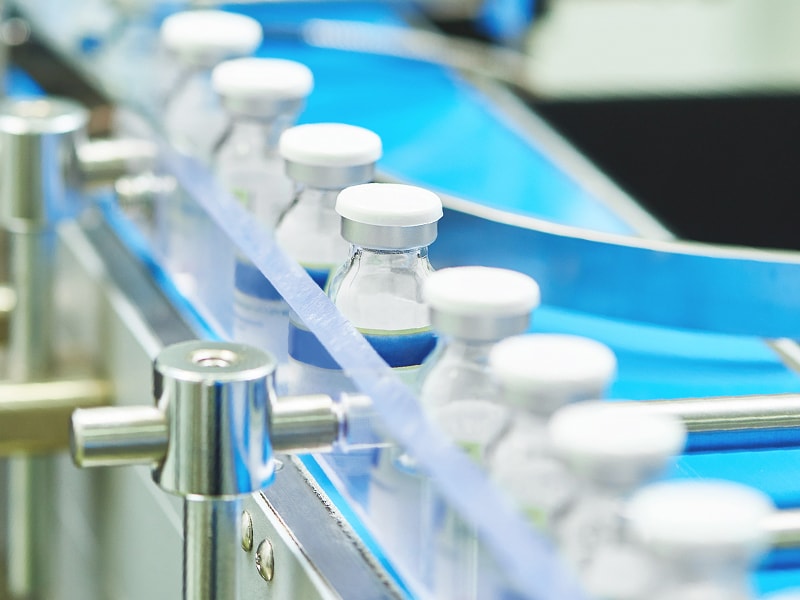
The pharmaceutical industry faces immense pressures from increasing research and development costs to competition from generics, and ever-tightening regulatory demands.
Traditional methods are no longer sufficient to meet these challenges. Enter AI-powered machine vision systems: a high-tech, in-line solution to automate key processes, maintain regulatory compliance, and address production challenges in real time.
Key Challenges in Pharmaceutical Manufacturing
Pharmaceutical companies face several significant challenges that can impede their progress, including:
- Rising Research and Development Costs: Drug development, particularly for new treatments and medications, is an expensive endeavor that requires more investment as research becomes increasingly complex.
- Regulatory Compliance: Pharmaceutical companies must meet strict regulatory standards set by health authorities, making it necessary to implement robust quality control systems that preserve product safety and compliance at every stage of production.
- Manufacturing Efficiency: Pharmaceutical production lines need to maintain high efficiency to meet market demand, all while maintaining the safety and quality of the final product.
- Defect Detection: Given the high volume of products being manufactured, the identification of defects, contamination, or mislabeling needs to be swift and accurate to prevent costly recalls or damage to brand reputation.
We’re here to provide you with more details.
Reach out today!

The Role of Machine Vision in Pharmaceutical Manufacturing
Machine vision systems offer an efficient solution to automate key production processes such as defect detection, product sorting, and labeling accuracy. KEYENCE AI vision systems incorporate AI-driven algorithms, enabling real-time analysis of vast amounts of production data.
By incorporating machine vision into their manufacturing processes, pharmaceutical companies can improve operational efficiency. AI-powered systems can quickly identify inconsistencies and make immediate adjustments, streamlining production and ensuring high-quality standards.
Key Areas for Machine Vision Applications in Pharmaceutical Manufacturing
Machine vision can be used in various areas of pharmaceutical manufacturing, including:
- Packaging Inspection: Ensures the integrity of product packaging, from label accuracy to barcode scanning, using advanced AI vision systems.
- Labeling & Coding: Verifies that every product is correctly labeled with lot codes, expiration dates, and other information.
- Fill Level Checks: Ensures each vial, bottle, or capsule is filled to the correct level to prevent product waste and verify dosing accuracy.
- Defect Identification: Identifies potential defects in tablets, capsules, and other products, such as chips, scratches, or contamination.
Discover more about this product.
Click here to book your demo.

Innovation in Drug Discovery and Development
Adapting to Technological Advances
AI vision systems help manufacturers keep pace with industry demands by offering real-time data processing and the ability to analyze and respond to production needs. They also accelerate drug discovery and development by automating time-consuming manual tasks.
Automation in Inspections
Automation is needed to improve production efficiency and reduce human error. With the adoption of machine vision systems, pharmaceutical manufacturers can automate many manual processes and provide consistent product quality.
Machine Vision Solutions for Pharmaceutical Companies
Real-Time Quality Control Monitoring
Machine vision systems, such as the KEYENCE VS Series, offer real-time monitoring to verify that all products meet quality standards before they leave the production line. These systems utilize high-resolution cameras and AI algorithms to detect defects, label errors, and other inconsistencies during the manufacturing process and provide an immediate corrective response.
AI-Powered Defect Detection
Traditional systems often miss small defects or inconsistencies that can result in product recalls or quality issues. AI vision systems can identify these defects with remarkable accuracy, significantly reducing the risk of defective products reaching the market.
With the ability to learn and adapt to new defect patterns, AI for machine vision continues to improve, identifying the most difficult defects and having them removed from production.
Tamper Detection for Product Safety
Product safety is a top priority in the pharmaceutical industry. Machine vision systems monitor packaging conditions, detect tampering, and make sure that products remain safe during transport and storage; they also identify anomalies like seal breaches or damaged packaging, which prevent potentially dangerous products from being distributed.
Get detailed information on our products by downloading our catalog.
View Catalog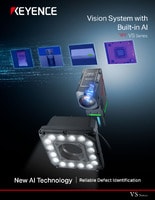
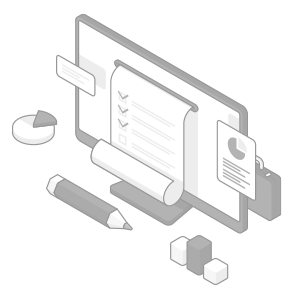
Advanced Features of AI in Machine Vision Systems
AI-Driven Risk Assessment Tools
AI-powered risk assessment tools allow machine vision systems to predict potential issues in the production process based on historical data and patterns, helping manufacturers address problems before they escalate, improve operational stability, and minimize disruptions.
Training Machine Vision Systems with Large Datasets
To achieve higher levels of accuracy, machine vision systems must be trained on large datasets, as AI systems can learn from a broad range of visual data. The training process is further simplified with the use of KEYENCE AI Auto Image Selector software, which significantly reduces learning and setup times.
The Benefits of KEYENCE Vision Systems for Pharmaceutical Manufacturers
Increased Production Efficiency
By automating inspections and reducing the need for manual labor, KEYENCE AI vision systems improve production efficiency. These systems support pharmaceutical manufacturers in maintaining high production rates without compromising product quality.
Enhanced Quality Assurance
Machine vision systems provide consistent, high-quality inspections that are not dependent on human operators; this leads to fewer errors, lower defect rates, and better overall product quality. KEYENCE AI vision systems confirm that only the highest-quality products make it to the market.
Embracing AI-Powered Machine Vision in Pharmaceutical Manufacturing
Pharmaceutical manufacturers are increasingly turning to AI vision systems to stay ahead of the competition, reduce costs, and meet regulatory requirements. Companies can automate inspections, improve product quality, and increase efficiency.
Ready to enhance your manufacturing efficiency with AI-powered machine vision? Contact KEYENCE today to learn how our solutions can help you stay ahead of the competition!
Contact us to learn more about how our advanced technology can help take your business to the next level.
Contact Us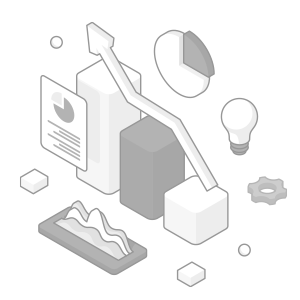
FAQs
How Can Machine Vision Systems Reduce Labor Costs in Pharmaceutical Manufacturing?
Machine vision automates repetitive tasks, reducing the need for manual labor and lowering overall labor costs. This allows employees to focus on higher-value tasks, ultimately improving efficiency and reducing operational expenses.
Can Machine Vision Systems Be Integrated Into Existing Pharmaceutical Production Lines?
Yes. Machine vision systems adapt easily into existing production lines with minimal disruption.
How Long Does It Take to Train a Machine Vision System for a New Pharmaceutical Product?
Training typically takes a few hours to days, depending on product complexity.
Can Machine Vision Systems Improve Regulatory Compliance in Pharmaceutical Manufacturing?
Yes, machine vision makes sure that products meet regulatory standards and provides detailed data for audits and reporting.
We’re here to provide you with more details.
Reach out today!

Related Downloads
Related Products
Applications
- 2D Measurement Inspection
- Optical Character Reading (OCR) and 1D/2D Code Verification
- Inline 3D Volume and Measurement Inspection
- Presence & Absence Inspection
- Flaw Detection
- 3D Vision-Guided Robotic Bin Picking
- High-Resolution Line Scan Cameras for High-Speed Imaging
- Automated Positioning and Alignment Systems Using Machine Vision
Industries
- Automotive
- Automation Equipment/Machine Building
- Electric Vehicles
- Medical Device Manufacturing
- Food/Beverage Packaging
- Semiconductor/Manufacturing Electronics
- Vision-Guided Robotics
- Solar
- Logistics
- Commodities
- Paper Manufacturing
- Machine Tools
- Electronic Device
- Printing
- Mining/Metals
- Fabric/Textile
- Tobacco
- Marine
- Aerospace

